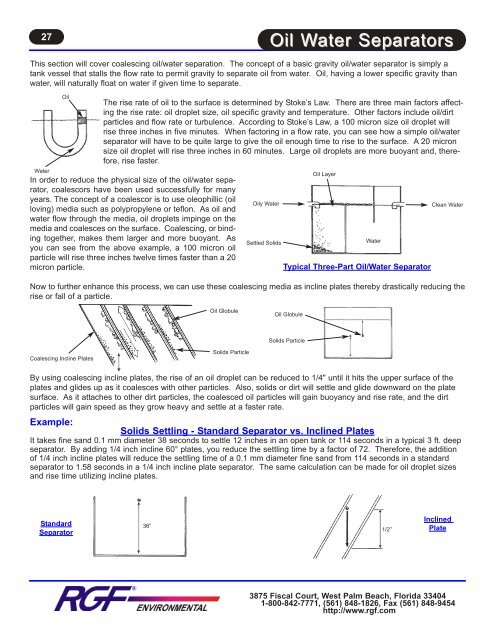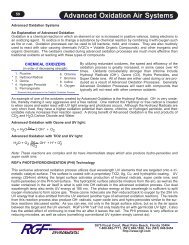Oil Water Separators
Oil Water Separators
Oil Water Separators
Create successful ePaper yourself
Turn your PDF publications into a flip-book with our unique Google optimized e-Paper software.
27<br />
<strong>Oil</strong> <strong>Water</strong> <strong>Separators</strong><br />
This section will cover coalescing oil/water separation. The concept of a basic gravity oil/water separator is simply a<br />
tank vessel that stalls the flow rate to permit gravity to separate oil from water. <strong>Oil</strong>, having a lower specific gravity than<br />
water, will naturally float on water if given time to separate.<br />
<strong>Water</strong><br />
<strong>Oil</strong><br />
The rise rate of oil to the surface is determined by Stoke’s Law. There are three main factors affecting<br />
the rise rate: oil droplet size, oil specific gravity and temperature. Other factors include oil/dirt<br />
particles and flow rate or turbulence. According to Stoke’s Law, a 100 micron size oil droplet will<br />
rise three inches in five minutes. When factoring in a flow rate, you can see how a simple oil/water<br />
separator will have to be quite large to give the oil enough time to rise to the surface. A 20 micron<br />
size oil droplet will rise three inches in 60 minutes. Large oil droplets are more buoyant and, therefore,<br />
rise faster.<br />
In order to reduce the physical size of the oil/water separator,<br />
coalescors have been used successfully for many<br />
years. The concept of a coalescor is to use oleophillic (oil<br />
loving) media such as polypropylene or teflon. As oil and<br />
water flow through the media, oil droplets impinge on the<br />
media and coalesces on the surface. Coalescing, or binding<br />
together, makes them larger and more buoyant. As<br />
you can see from the above example, a 100 micron oil<br />
particle will rise three inches twelve times faster than a 20<br />
micron particle.<br />
<strong>Oil</strong>y <strong>Water</strong><br />
Settled Solids<br />
<strong>Oil</strong> Layer<br />
Now to further enhance this process, we can use these coalescing media as incline plates thereby drastically reducing the<br />
rise or fall of a particle.<br />
<strong>Water</strong><br />
Typical Three-Part <strong>Oil</strong>/<strong>Water</strong> Separator<br />
Clean <strong>Water</strong><br />
<strong>Oil</strong> Globule<br />
<strong>Oil</strong> Globule<br />
Solids Particle<br />
Coalescing Incline Plates<br />
Solids Particle<br />
By using coalescing incline plates, the rise of an oil droplet can be reduced to 1/4" until it hits the upper surface of the<br />
plates and glides up as it coalesces with other particles. Also, solids or dirt will settle and glide downward on the plate<br />
surface. As it attaches to other dirt particles, the coalesced oil particles will gain buoyancy and rise rate, and the dirt<br />
particles will gain speed as they grow heavy and settle at a faster rate.<br />
Example:<br />
Solids Settling - Standard Separator vs. Inclined Plates<br />
It takes fine sand 0.1 mm diameter 38 seconds to settle 12 inches in an open tank or 114 seconds in a typical 3 ft. deep<br />
separator. By adding 1/4 inch incline 60° plates, you reduce the settling time by a factor of 72. Therefore, the addition<br />
of 1/4 inch incline plates will reduce the settling time of a 0.1 mm diameter fine sand from 114 seconds in a standard<br />
separator to 1.58 seconds in a 1/4 inch incline plate separator. The same calculation can be made for oil droplet sizes<br />
and rise time utilizing incline plates.<br />
Standard<br />
Separator<br />
36”<br />
1/2”<br />
Inclined<br />
Plate<br />
3875 Fiscal Court, West Palm Beach, Florida 33404<br />
1-800-842-7771, (561) 848-1826, Fax (561) 848-9454<br />
http://www.rgf.com
<strong>Oil</strong> <strong>Water</strong> <strong>Separators</strong><br />
28<br />
In addition to incline plate coalescing separation, RGF utilizes a Micro-Matrix Coalescor system of finely spaced poly<br />
mesh with an incline grid matrix. For final polishing, a HCA-3 absorbent filter is recommended. This filter consists of<br />
millions of very fine polypropylene hair-like fibers that crisscross into the water stream to attract and hold oil droplets less<br />
than 9 microns in size.<br />
<strong>Oil</strong> Globules<br />
Trace <strong>Oil</strong>s & <strong>Water</strong><br />
<strong>Oil</strong> Free <strong>Water</strong><br />
Solids Particles<br />
<strong>Oil</strong> Droplets < 9 microns<br />
in size<br />
Magnified View of the<br />
Micro-Matrix Coalescor<br />
Magnified view of the<br />
HCA-3 Hydrocarbon Absorber<br />
This RGF system of micro matrix and HCA-3 hydrocarbon absorbers are used in our Marine Bilge Filter Systems and<br />
has achieved results of 0.87 ppm during a two day UL/U.S. Coast Guard Test consisting of blended 25% to 100% diesel<br />
fuel and oil under simulated sea conditions.<br />
The addition of auto oil skimmers and the RGF <strong>Oil</strong> Accumulator makes free oil removal easy.<br />
<strong>Oil</strong> Skimmer<br />
<strong>Oil</strong> Layer<br />
Note:<br />
The use of RGF’s OWS<br />
Bio-Disks can reduce both<br />
free and emulsified oils by<br />
greater than 50% using<br />
natural bacteria<br />
Accumulated<br />
Free <strong>Oil</strong>s<br />
<strong>Water</strong><br />
Emulsified oils, either chemically or mechanically emulsified, will not separate in a gravity separator. Emulsion splitting<br />
methods will be necessary before the emulsion reaches the separator. Alternately, quick release detergents or cleaning<br />
chemicals can be used, which will release the emulsion and permit the gravity action to occur. Alternately, a floccing or<br />
membrane system can be used for emulsified oily water problems.<br />
NATURAL SETTLING<br />
WATER VOLUME VS. 15 PPM OF OIL CONTAMINATION<br />
Diameter of<br />
particles, mm<br />
Order of Size<br />
Time Required to Settle<br />
OIL<br />
1 Drop<br />
3/4 Pint<br />
4 Quarts<br />
in<br />
in<br />
in<br />
WATER<br />
1 Gallon<br />
4,000 Gal. Tanker Truck<br />
50 gpm flow over 24 hrs.<br />
(72,000 Gals.)<br />
10<br />
1<br />
0.1<br />
0.01<br />
0.001<br />
0.0001<br />
0.00001<br />
Gravel<br />
Coarse Sand<br />
Fine Sand<br />
Silt<br />
Bacteria<br />
Colloidal Particles<br />
Colloidal Particles<br />
0.3 seconds<br />
3.0 seconds<br />
38 seconds<br />
33 minutes<br />
55 hours<br />
230 days<br />
6.3 years<br />
3875 Fiscal Court, West Palm Beach, Florida 33404<br />
1-800-842-7771, (561) 848-1826, Fax (561) 848-9454<br />
http://www.rgf.com
29<br />
<strong>Oil</strong> <strong>Water</strong> <strong>Separators</strong><br />
Model OWS-10<br />
<strong>Oil</strong> <strong>Water</strong> Separator<br />
RGF's OWS-10 System of pre-treatment technology is<br />
designed to avoid pollution problems by avoiding contaminated<br />
water discharge. It is a compact system designed to<br />
remove free oils from water prior to discharge for sanitary<br />
sewer or other treatment.<br />
• Flow Rate<br />
10 gpm<br />
• Dimensions: 35”W x 35”L x 36”H<br />
• System Capacity: 120 gallons<br />
• Free <strong>Oil</strong> Capacity: 10 gallons<br />
• Separation Type: 1/4” Vertical Tube Coalescor,<br />
Gravity Separation, Micro-Matrix<br />
Coalescor<br />
• Materials:<br />
Polyethylene / Polypropylene / PVC<br />
• Options:<br />
RGF OWS Bio-Disks for oil reduction<br />
Item #<br />
OWS-10-Q<br />
Fl-093<br />
Description<br />
Model OWS-10<br />
Small Permanent Coalescing Filter<br />
Ship Weight<br />
268 Lbs.<br />
Models OWS-20 & OWS-50<br />
<strong>Oil</strong> <strong>Water</strong> <strong>Separators</strong><br />
Shown - OWS-50<br />
RGF's <strong>Oil</strong> <strong>Water</strong> <strong>Separators</strong> are designed to process wastewater<br />
containing free oils. The patented systems utilize over<br />
five technologies to remove and store the free oils before discharge<br />
for reclaim or sanitary sewer.<br />
• Flow Rate<br />
OWS-20: 20 gpm<br />
OWS-50: 50 gpm<br />
• Dimensions: OWS-20: 26”W x 50”L x 46”H<br />
OWS-50: 76”W x 56”L x 54”H<br />
• System Capacity: OWS-20: 180 gallons<br />
OWS-50: 550 gallons<br />
• Free <strong>Oil</strong> Capacity: OWS-20: 7 gallons<br />
OWS-50: 7 gallons<br />
• Separation Type: 1/4” Inclined Tube Coalescor,<br />
Gravity Separation, Micro-Matrix<br />
Coalescors<br />
• Materials:<br />
Polyethylene / Polypropylene / PVC<br />
• Options:<br />
RGF OWS Bio-Disks for oil reduction<br />
Item #<br />
OWS-20A-Q<br />
OWS-50A-Q<br />
FL-093<br />
SA-IP-SM-02<br />
SA-IP-LG-02<br />
Description<br />
Model OWS-20<br />
Model OWS-50<br />
Small Permanent Coalescing Filter<br />
Small Incline Plate Pack<br />
Large Incline Plate Pack<br />
Ship Weight<br />
312 Lbs.<br />
1067 Lbs.<br />
3875 Fiscal Court, West Palm Beach, Florida 33404<br />
1-800-842-7771, (561) 848-1826, Fax (561) 848-9454<br />
http://www.rgf.com
<strong>Oil</strong> <strong>Water</strong> <strong>Separators</strong><br />
30<br />
Model SD I<br />
Sewer Discharge <strong>Oil</strong> <strong>Water</strong> <strong>Separators</strong><br />
RGF's Sewer Discharge Systems are designed to collect contaminated source water, which typically contains petroleum hydrocarbons,<br />
heavy metals solid and cleaning fluids. The collected water is processed through the system and contaminants are removed<br />
utilizing over 12 technologies prior to discharge to sewer.<br />
• Flow Rate:<br />
30 gpm<br />
• Dimensions: 76”W x 56”L x 84”H<br />
• System Capacity: 850 gallons<br />
• Free <strong>Oil</strong> Capacity: 7 gallons<br />
• Separation Type: 1/4” Inclined Tube Coalescor, Gravity Separation,<br />
Micro-Matrix Coalescors, Multi-Media Absorption<br />
• Final Filtration Media: 638 lbs. Multi-Media<br />
Multi-Media consists of Activated Alumina, Carbon,<br />
• Oxidation System:<br />
• Materials:<br />
• Options:<br />
Activated Carbon, Volcansorb Rock<br />
TurboHydrozone ® (XL only)<br />
Polyethylene / Polypropylene / PVC<br />
RGF OWS Bio-Disks for oil reduction<br />
Coalescing Centrifugal Separator (XL only)<br />
Item #<br />
SD-I-Q<br />
SD-I-XL-Q<br />
OI-002<br />
OI-004<br />
Fl-096X<br />
Fl-101<br />
Description<br />
Model SD-I<br />
Model SD-I w/ TurboHydrozone ® & H.E.C.S.<br />
Coalescing Separator for Model SD-II<br />
TurboHydrozone ® for Model SD-II<br />
HCA-2 Filter - SD-I & SD-I-XL<br />
Filter Media - SD-I & SD-I-XL<br />
Ship Weight<br />
726 Lbs.<br />
756 Lbs.<br />
Model SD II<br />
Sewer Discharge <strong>Oil</strong> <strong>Water</strong> <strong>Separators</strong><br />
• Flow Rate:<br />
15 gpm<br />
• Dimensions: 56”W x 32”L x 54”H<br />
• System Capacity:<br />
250 gallons<br />
• Free <strong>Oil</strong> Capacity:<br />
• Separation Type:<br />
• Final Filtration Media:<br />
7 gallons<br />
1/4” Inclined Tube Coalescor, Gravity Separation,<br />
Micro-Matrix Coalescors, Multi-Media Absorption<br />
161 lbs. Multi-Media<br />
Multi-Media consists of Activated Alumina, Carbon,<br />
• Materials:<br />
• Options:<br />
Activated Carbon, Volcansorb Rock<br />
Polyethylene / Polypropylene / PVC<br />
RGF OWS Bio-Disks for oil reduction<br />
Item #<br />
SD-II<br />
OI-002<br />
OI-004<br />
FL-012<br />
FL-001-X<br />
Description<br />
Model SD-II<br />
Coalescing Separator for Model SD-II<br />
TurboHydrozone ® for Model SD-II<br />
Filter Media - SD-II<br />
HCA-2 Filter - SD-II<br />
Ship Weight<br />
310 Lbs.<br />
3875 Fiscal Court, West Palm Beach, Florida 33404<br />
1-800-842-7771, (561) 848-1826, Fax (561) 848-9454<br />
http://www.rgf.com











